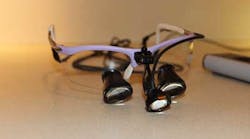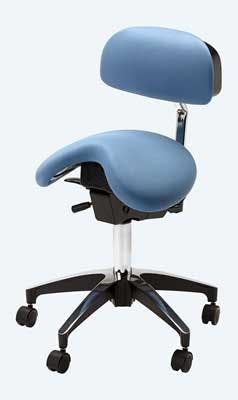Recently, I just purchased new loupes. I had been using my old ones for 12 years (including dental school) and have known that for some time I would need to make the investment to get new ones. I got sized for the new pair and didn’t think twice about using them. After three days of use, I felt like I had aged 20 years. My neck was sore, and my upper back and shoulders were fatigued in a way that they have never been. Three days! This was an eye-opening experience for me on how proper form can have a severe impact on physical well-being, both long and short term.
ADDITIONAL READING |The economics of ergonomics: 3 steps to maintain longevity throughout your dental career
The definition of good/proper posture is when the head is centered over the shoulders and spine and the cervical curve maintains ideal positioning. By that definition, as dentists, we deviate from that model every day we see patients. With poor ergonomics, we may not notice it on a day-to-day basis, but long term, the progression of musculoskeletal disease (MSD) is slow, yet inevitable. MSD is when improper, repetitive motion causes minor physical disabilities that create pain and discomfort in day-to-day activities. It is extremely common and increases with age. Early diagnosis, treatment, and change in habits are all components to being able to lead a pain-free and active lifestyle.
ALSO BY DR. STACEY SIMMONS |Quick tips on how to be a better clinical provider within all disciplines of dentistry
Dentists are especially vulnerable to MSDs. An average of two out of three dental professionals experience occupational pain (1) and, as such, MSD forces early retirement for nearly one-third of dentists. (2) The economic impact cannot be ignored. In 2004, approximately $131 million in lost income in the dental profession was attributed to MSD. (3) These numbers are staggering!
What exactly happens when we try to bend like a pretzel to do that DO resin on tooth No. 14 (or any filling for that matter)? Picture this: a rod (the neck) holding a bowling ball (our head) straight up. The weight is centered over the rod and, therefore, the position is easily maintained. Now, angle that rod and bowling ball 10% to 15% one way. What happens? The weight and effort of holding that ball up increase exponentially. Increase that angle even more (as you do when doing that filling, crown, or extraction) and the weight is even more. On average, the weight of a human head is eight to 12 pounds. When we lean forward, our muscles in the neck and mid-back (occipital, trapezius, and rhomboid muscles) must contract to maintain the static position and weight of our head when we work. Over time, this causes fatigue and furthermore creates a muscle memory that will be reverted back to when you bend over again. Essentially, we are training our muscles improperly! (4) Arthritis, joint degeneration, headaches, neck/back pain, and numbness with tingling are all complications of poor ergonomics.
If you are one who suffers from chronic neck and back pain, then seek the services of a physical therapist. Physical therapists can come to the office to do an ergonomic assessment and then create a specific recovery program to help decrease inflammation, reset and retrain your muscles, help put motion back into your joints, and re-stimulate nerve communication. (7) If needed, a referral can be given to a chiropractor and a massage therapist.
Your dental equipment — chairs, loupes, handpiece delivery system, etc. — can play a big role in ergonomics. Orascoptic manufactures a “saddle chair” that helps maintain ideal posture, which in turn, allows for proper provider/patient positioning. (5) An ergonomic how-to guide is also beneficial to reference when working on the maxillary vs. mandibular arches. (6)
Aside from proper positioning, there are things that can be done outside the office to ensure health and longevity for your dental career. Engage in exercise, both muscle and cardiovascular. Muscle toning and strengthening of the head/neck and back muscles are especially beneficial — i.e., lap pulls, rows, and swimming. Running and walking are easy, well-rounded forms of exercise. Despite busy schedules, being creative and incorporating these types of exercises into a routine can be done! Proper diet and nutrition will also help facilitate ligament and bone care — i.e., calcium, Vitamin C and D, magnesium, and manganese. (6)
Even after having my loupes adjusted, it has taken almost two weeks to feel normal again. Old habits are hard to break, so if you are feeling a little tight and sore in your head, neck, and shoulder areas, then make a change! With proper ergonomics, you will have the ability to practice in a more efficient, healthy, and long-term manner.
ALSO BY DR. STACEY SIMMONS |Acute primary herpetic gingivostomatitis: a case report
References
1. Rucker, et al., Ergonomic risk factors associated with clinical dentistry. Journal of the California Dental Association, Feb. 2002;30(2):139-148.
2. Burke FJ, Main JR, Freeman R. The practice of dentistry: an assessment of reasons for premature retirement. Br Dent J. 1997;182:250-254.
3. Valachi B. Practice Dentistry Pain-Free: Evidence-Based Strategies to Prevent Pain and Extend Your Career. Portland, Ore: Posturedontics Press; 2008.
4. Marston J. D.C. 5537 Old Highway 93, Ste. A. Florence MT 59833. www.florencechiro.com.
5. http://www.orascoptic.com/bodyguard-pro
6. http://www.dentistrytoday.com/ergonomics/3481-ergonomic-positioning-a-few-degrees-add-years-to-your-career
7. Humphrey J. DPT, MTC, CFS. 1016 Brooks Avenue Corvallis MT 59828. www.willowcreekpt.com.







